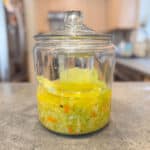
Sauerkraut
Servings 8 cups
Ingredients
- 1 large (3-4 lb) cabbage (red or green)*
- 3-4 tbsp kosher salt*
- 1-2 tsp caraway seeds, mustard seeds, or other pickling spices (optional)**
Optional:
- Grated ginger and/or turmeric
- *You’ll need 1 tablespoon of kosher salt per pound of cabbage.
- **Caraway seeds are what you’ll typically find in German kraut. I love using mustard seeds. You can also just buy “pickling spices” and use that.
- If not enough brine: ~ make your own brine by stirring together 1 cup of water with 1 heaping teaspoon of kosher salt (or 100g water + 2g salt).
- What vessel to use: ~ I used to use these jars, but I lost them and so I’m trying it out with these ones. You can find fermentation specific crocs that come with weights. Just make sure whatever you use is big enough and you can fit your fist in it. You could also use multiple smaller jars.
Important tips:
- Make sure to keep everything clean and sanitized (clean bowl, clean hands, etc…).
- If mold forms on top while it’s fermenting, scrape it off carefully and keep fermenting (you may need to add more brine).
- You can always add more salt water brine if you think it's too low and/or if mold begins to grow. Better to air on the side of too much brine than too little.
- Throw out the sauerkraut if it becomes discolored, slimy, or if it smells rotten.
Instructions
- Remove the outer leaves of your cabbage and set those aside (we’ll use them to weigh down the cabbage later). Thinly slice your cabbage either by hand, using a mandholin, or you can use a food processor with a grating attachment.
- To a large bowl, add roughly ¼ or ⅓ of the cabbage. Sprinkle with 1 tablespoon salt and use your hands to massage it into the cabbage. Repeat with the remaining cabbage and salt.
- Use your hands to knead and squeeze cabbage for about 5 minutes. This will help to start to extract the liquid out of the cabbage. Your hands will tire or freeze, so take 10 minute breaks and keep going until an ample amount of liquid has been released (this will be your brine). There should be enough brine to cover the cabbage when you press it down. If you aren’t getting enough brine, see note on how to add your own brine.
- Transfer the cabbage to whatever vessel you will be fermenting it in (see note). I use tongs to transfer the cabbage, then I pour the brine in (don’t lose any of that valuable brine!).
- Use a tight fist to pack the cabbage down as much as possible so you have a very compact layer that is covered by at least ½-inch of brine. If there is not enough brine, add the salt water solution to cover (see note).
- To further weigh it down, place the reserved cabbage leaves on top and use a weight to weigh it down. If you don’t have a weight, just fill up a glass mason jar with water and place it on top of the cabbage (that’s what I do).
- Cover tightly with a lid and store it in a cool dark place. Check on the cabbage every day or few days to make sure it is still submerged in the liquid - this will ensure no mold or bacteria grows.
- After a few days, you should notice some bubbling. Always check on it but don’t remove the lid unless you have to (the more you open it, the greater chance mold could grow). If the cabbage is above the brine, press it down with clean hands or add more brine.
- If mold does grow on the surface, carefully scrape it off and continue to ferment the kraut.
- You’ll know the kraut is ready when it tastes very sour and this can take anywhere between 2-4 weeks (the longer you leave it out, the more sour it will get so it’s up to you).
- Once you think it’s ready, transfer the kraut to whatever jars or containers you want to store it in (I like the 16 oz mason jars). Pour the brine over the kraut in each jar (that brine is called kvass and has a lot of probiotics in it as well). Store in the fridge for up to 6 months.